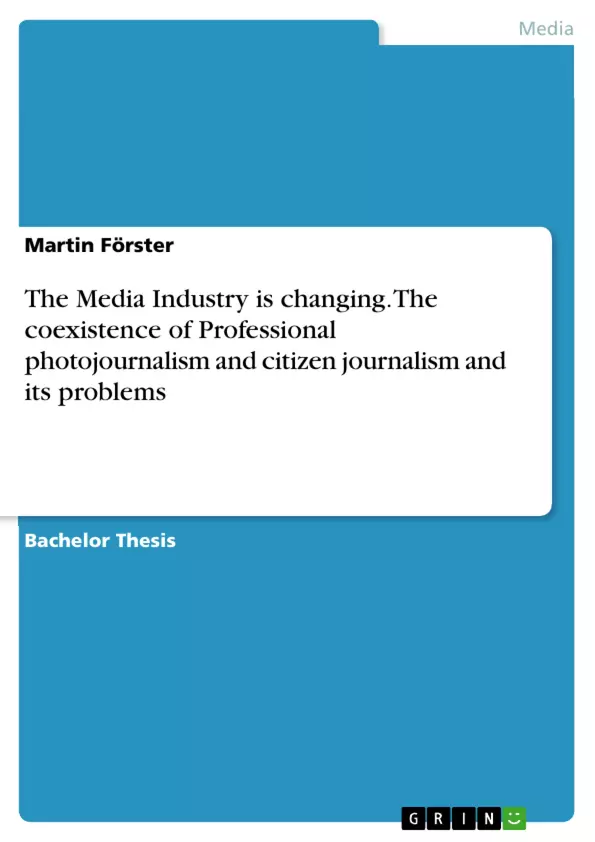Journalism and the whole media industry as we know them today are changing dramatically. Through the rapid development of smart phones and the improvement of cameras we are noticing a dramatic change in the way journalism is used and how photojournalism is affected. The usage of “citizen journalism” has increased hundredfold and it is still rising.
In this dissertation I want to take a closer look on this new phenomenon to discover if it is becoming a problem for professional photojournalists and if it affects the way how images are published.
Every professional news agency today has many further sources – such as twitter, Flickr or Facebook - to choose from, which is advantageous on the one hand, but isn’t it a step in a direction that could let professional photojournalism “die”?
But what are the reasons for that? Is it the next logical step in the development of photojournalism or is it “killing” the classical photojournalism, as we know it?
In this dissertation I want to find out how professionals and citizen journalists coexist and what are the possible problems that this relationship could cause.
To understand what citizen journalism is in detail, I want to take a closer look at the three variations that this kind of journalism has for me. To find a precise definition is not easy, as this kind of journalism is relatively new and even sources like Wikipedia don`t find a clear answer.
1. Accidential Journalists
In the broader sense, all eyewitnesses with a smartphone are accidential journalists, as they witness a situation because they pass by.
2. Amateur Journalists
A good example for amateur journalists are bloggers
who might do a lot of research and try to expose hidden issues.
3. Citizen Journalists
Citizens with a clear vision and political or humanistic interests are best suitable for the term “citizen journalist”.
Inhaltsverzeichnis (Table of Contents)
- Chapter I - A brief overview
- Ireport
- Rodney King Beating
- Chapter II - A comparison
- Social Media Case Study
- Be the First on the Site
- Who to Trust?
- Citing Work
- A Possible Dissident?
- Can a Phone Photo Generate Sympathy?
- Telling It the Right Way
- Ethical Aspects of Photojournalism
- Chapter III - The Industry is Changing
- People's Expectation on Image Quality?
- From an Image Editor's View
- From a Reader's View
Zielsetzung und Themenschwerpunkte (Objectives and Key Themes)
This dissertation examines the rise of citizen journalism and its impact on professional photojournalism. The author aims to understand how these two forms of journalism coexist and what challenges their relationship poses. The focus of the work is on the changing media industry, the role of smartphones in newsgathering, and the ethical implications of citizen-generated content.- The changing landscape of photojournalism
- The rise of citizen journalism and its impact on professional photojournalists
- The role of social media platforms in news dissemination
- The ethics of photojournalism in the digital age
- The economic challenges facing traditional media organizations
Zusammenfassung der Kapitel (Chapter Summaries)
Chapter I - A brief overview
This chapter introduces the concept of citizen journalism and its rapid growth, primarily due to the widespread adoption of smartphones and improved camera technology. The author examines how the rise of citizen journalism has affected the practice of photojournalism and discusses the potential for citizen journalism to threaten professional photojournalism.Chapter II - A comparison
This chapter delves deeper into the relationship between professional and citizen journalism by comparing and contrasting the two forms of media. The author examines a social media case study and explores the various challenges associated with citizen journalism, such as verifying information, ensuring accuracy, and upholding ethical standards.Chapter III - The industry is changing
This chapter analyzes the changing expectations of image quality in the digital age. The author explores perspectives from both image editors and readers, highlighting the evolving relationship between the public and journalistic images.Schlüsselwörter (Keywords)
This dissertation explores the intersection of traditional photojournalism, citizen journalism, social media, and the evolving landscape of the media industry. Key terms include citizen journalism, photojournalism, social media, iReport, ethical implications, image quality, and economic challenges.- Citar trabajo
- Martin Förster (Autor), 2013, The Media Industry is changing. The coexistence of Professional photojournalism and citizen journalism and its problems, Múnich, GRIN Verlag, https://www.grin.com/document/276250



